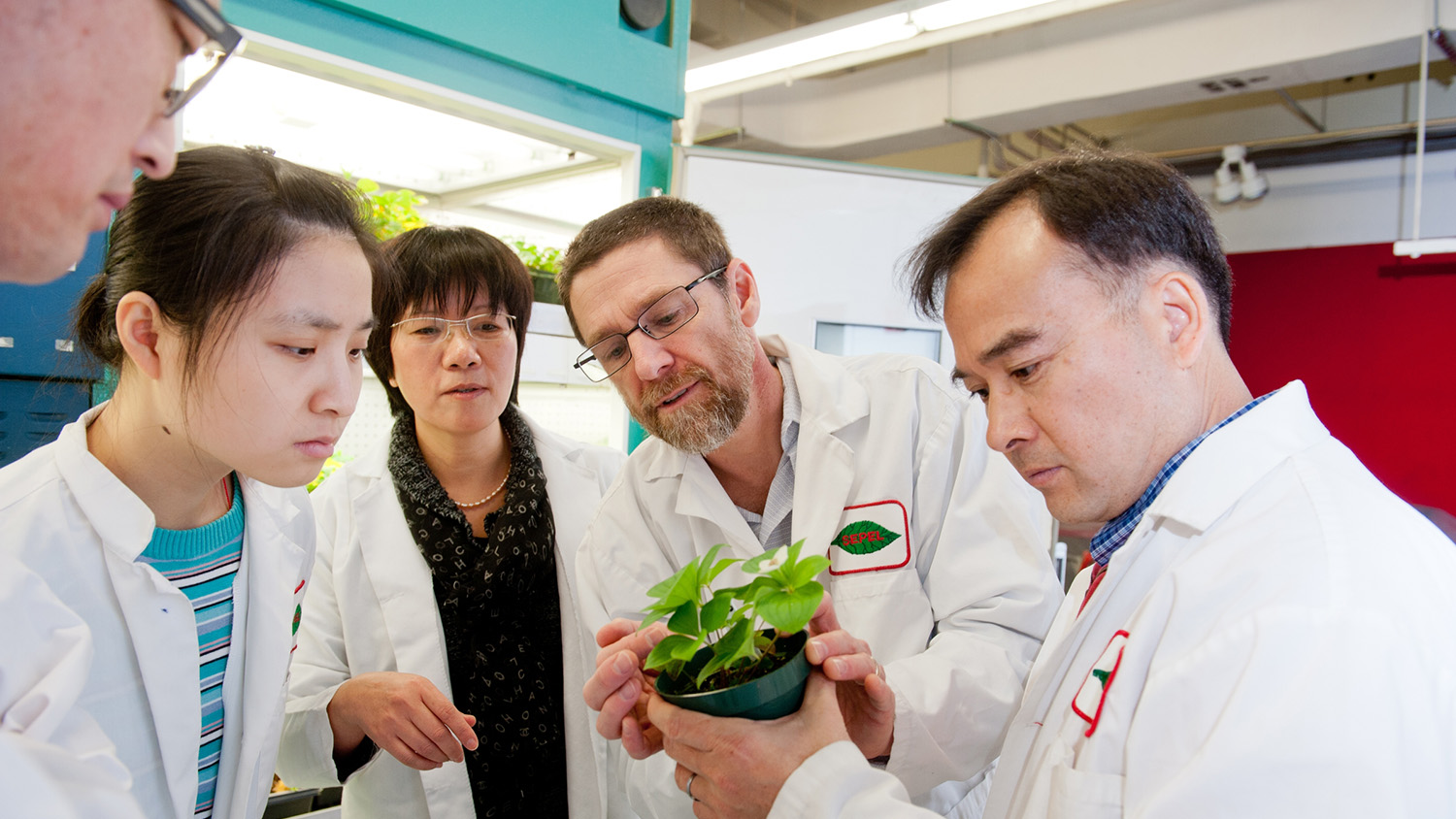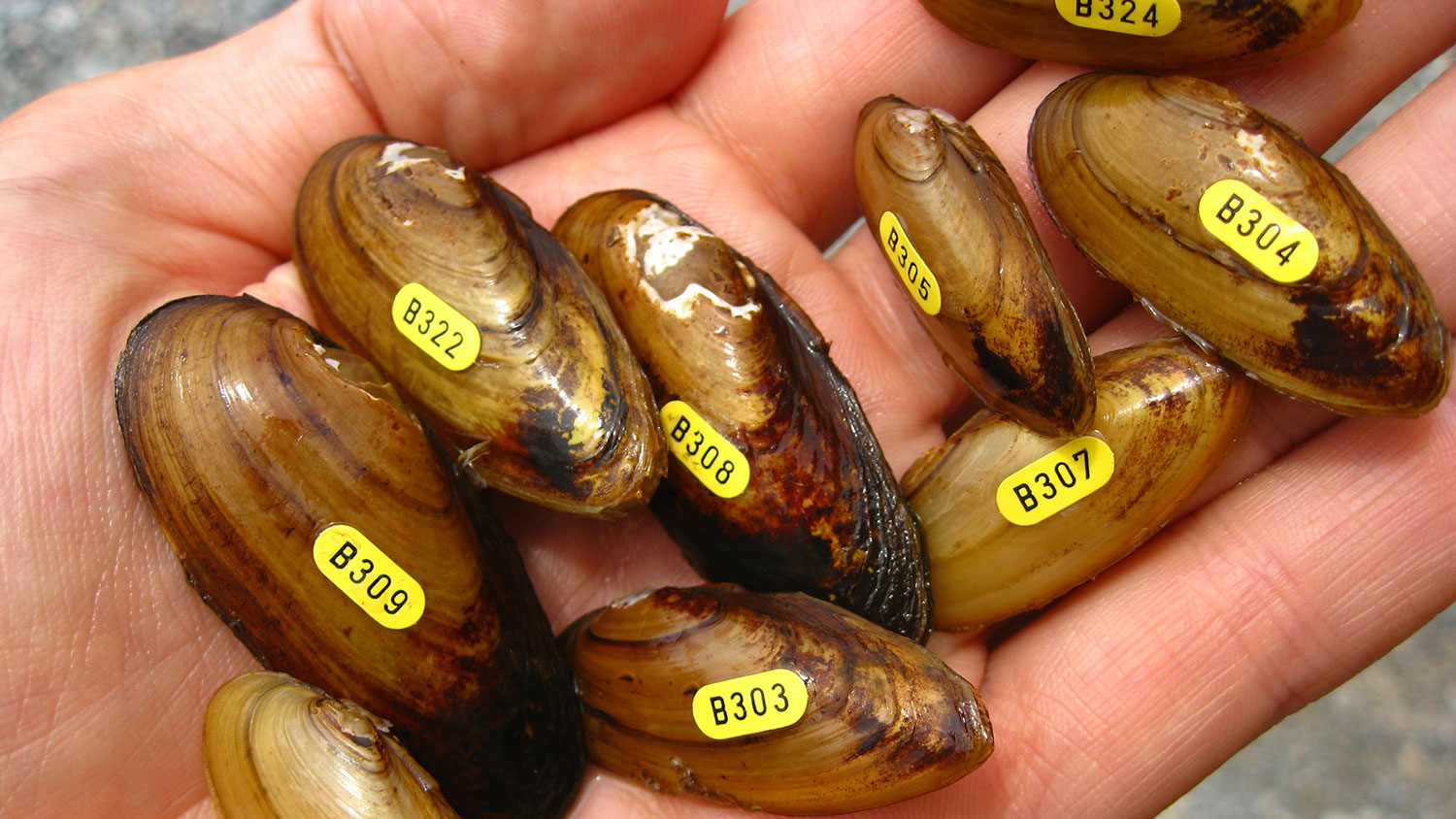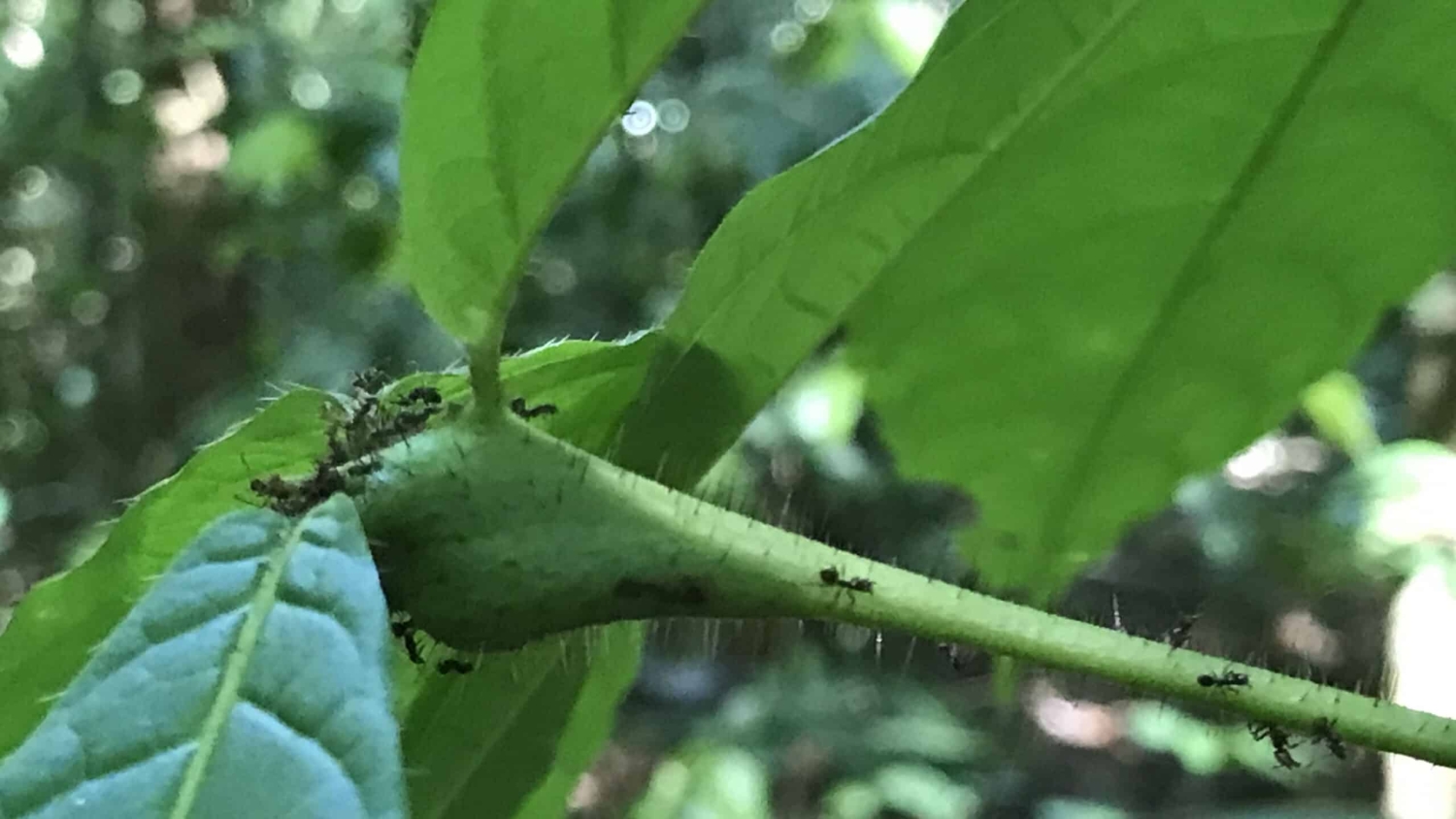Important implications: CALS team studies the distinct inflorescence structure of the dogwood

Researchers Qing Ma, Xiang Liu, Dr. Jenny Xiang, Dr. Bob Franks and Dr. Deyu Xie work with dogwood plants in the Phytotron.
Dr. Bob Franks of NC State University’s College of Agriculture and Life Sciences has a bone to pick with those who determined that the dogwood is the state flower of North Carolina.
“It actually should be called the ‘state inflorescence,’” Franks, associate professor of plant and microbial biology, said with a laugh. And Franks would know, having spent the past five years working on a National Science Foundation-funded grant to study the inflorescence architecture, or variation in the arrangement of flowers, of the dogwood.
“What most people think of as the dogwood flower is actually the dogwood inflorescence,” Franks said. “So those big white petals are not technically petals, they’re bracts made to look like petals. It’s a different strategy to attract insects for pollination.”
Franks, Dr. Jenny Xiang and Dr. Deyu Xie, his colleagues in the CALS Department of Plant and Microbial Biology, have worked together since 2010 to gain a better understanding of the evolution and development of different inflorescence architectures.
“Despite the importance of inflorescence architecture to humankind, little progress has been made in understanding how developmental and genetic changes have shaped inflorescence architectures in the diversity of flowering plants on earth,” said Xiang. “In this project, we’re using a multidisciplinary approach integrating phylogeny, developmental biology, genetics and biotechnology to understand the basis for the diversification of inflorescence architecture in the dogwood genus.”

Dogwoods are an ideal candidate for this research because all the different species exhibit very distinct inflorescence structures, Franks said. But they’re complex and difficult to work with. He typically works on Arabidopsis, the first fully sequenced plant genome and a model system that’s much easier to manipulate than dogwood.
“For 14 years we’ve had the full genome sequence of Arabidopsis,” Franks said. “It’s one of the best, if not the best, plant model systems. And dogwood species, in the genus Cornus, are very far toward the other end, in terms of being very difficult to work with. There are not many genomic resources available yet, and they’re also difficult to transform – to change the genes in a quick and easy fashion – in large part because they’re woody.
“But one of the nice things about dogwood is the variation in the inflorescence types in the different species, and so now our collaboration is trying to understand that on a more mechanistic level.”
Xiang, who has devoted her career to the study of dogwoods, explained that this highly theoretical research could have significant practical application.
“We’re working to understand what kinds of changes in the gene network may have led to the difference in the flower arrangements in the different lineages, because changing the inflorescence architecture is important for reproductive success and speciation.” she said.
“This greater understanding of the molecular mechanisms of inflorescence development and evolution may enable efforts to breed agricultural varieties with inflorescence structures to allow greater agricultural productivity. Essentially, if you have bigger inflorescence, then you might have bigger yields.”
Franks added, “Jenny’s point about the inflorescence architecture in agriculture is definitely a very important one. A lot of people are interested in manipulating the inflorescence structure in grains in order to increase harvest index.”
One of the dogwood project’s first big successes – a huge “technical hurdle,” Xiang said – was when she and her collaborative team became the first scientists to regenerate the dogwood by tissue culture. Then, in 2012, the team published an article for genetic transformation and began making transgenic plants.
“So now we have a bunch of different genetically engineered plants under observation, and we have made great progress to overcome one of the biggest hurdles of using dogwoods as a model, which is the generation time. We’ve been doing a number of different things to cause them to flower early.”
Xiang Liu, lab manager and research specialist in Xiang’s lab, was able to silence one of the genes that controlled vegetative growth, whittling the plants’ flowering time from three to five years down to six months.
Xiang’s lab also is running tests on heat resistance in transgenic plants that carry a heat-tolerance gene, and they’ve discovered that these plants survive long after the control plants die under high temperatures.
“We’re still working on adding more data, and this work is not published yet,” Xiang said. “This project is a direct application of our early research.”
The team’s work relies much on the successful plant culturing in the NC State University Phytotron, a collection of climate-controlled chambers and greenhouses that allows scientists to control the conditions under which plants are grown. The Phytotron recently completed a major renovation, thanks to a $1.79 million National Science Foundation grant.
According to the Phytotron’s director Dr. Carole Saravitz, the cost of the lab’s renovations will be paid off through energy savings over the next 10 to 15 years.
“The Phytotron growth chambers were being cooled with the original chillers from 1968, and we were slowly running out of capacity,” she said. “The major renovations were to the Phytotron cooling system. We also updated the lighting inside the growth chambers with more efficient fluorescent lights and resealed the greenhouses.”

In other dogwood research, Xiang also has initiated an effort to identify genes associated with disease resistance and drought tolerance.
“The first step is to understand the genetics,” Xiang said, “Then if we can confine the genes responsible for disease susceptibility and resistance, and using the genetic transformation systems we’ve developed here, we have the potential to actually manipulate the diseases and develop trees that are resistant to them.”
Xiang spearheaded an effort in the college to establish the Dogwood Fund to support the research and development of dogwoods with enhanced disease resistance and floral variety. Gifts to the fund will fuel plant exploration, genetic research and development of disease and stress resistant dogwood varieties. Contributors also have opportunities to participate in study abroad trips in Eastern China with Xiang.
Xiang and Franks will apply for renewal when their grant expires in July 2015. Xiang also has collaborated with scientists from the universities of Georgia and Tennessee to apply for funding to initiate a project to sequence the dogwood genome.
“One of the things that excites me about my work is the commonality that you see in natural systems,” Franks said. “It’s amazing to me that even across very diverse life forms such as animals and plants, there are some very similar molecular processes at work. There’s something beautiful to that, that suggests a unity of the developmental process and strongly supports that there is a common evolutionary origin to all these life forms.
“I’m learning new things all the time,” he said. “It doesn’t stop.”
– Suzanne Stanard
This post was originally published in College of Agriculture and Life Sciences News.


